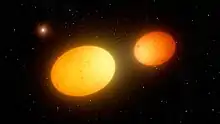Heartbeat star
Heartbeat stars are pulsating variable binary star systems with vibrations caused by tidal forces. The name "heartbeat" comes from the similarity of the light curve of the star with what a heartbeat looks like through an electrocardiogram if their brightness was mapped over time.[1][2] Many heartbeat stars have been discovered with the Kepler Space Telescope.[1]

Orbital information
Heartbeat stars are binary star systems in which each star rotates in a highly elliptical orbit around the common mass center, and the distance between the two stars varies drastically as they orbit each other.[1] Heartbeat stars can get as close as a few stellar radii to each other and as far as 10 times that distance during one orbit.[1][2] As the star with the more elliptical orbit swings closer to its companion, gravity will pull the star into a non-spherical shape, changing its light output.[3] At their closest point in orbit, the diameters of the heartbeat starts fluctuate rapidly.[2] When the stars reach the point of their closest encounter, the mutual gravitational pull between the two stars will cause them to become slightly ellipsoidal in shape, which is the reason for their light being so variable.[1]
Discoveries
The Kepler Space Telescope has discovered large numbers of heartbeat stars. One of the stars discovered, KOI-54, has been shown to increase in brightness every 41.8 days.[2] A subsequent study in 2012 characterized 17 additional objects from the Kepler data which were classified as heartbeat stars.[1][2] A study published in the Astrophysical Journal, which measured the orbits of 19 heartbeat star systems, found that surveyed heartbeat stars tend to be both bigger and hotter than the Sun.[4]
Star HD 74423, discovered using NASA's TESS satellite, was found to be unusually teardrop-shaped, which causes the star to pulsate only on one side, the first known heartbeat star to do so.[5][6]
References
- Landau, Elizabeth (22 October 2016). "'Heartbeat Stars' Unlocked in New Study". NASA. Retrieved 3 January 2019. As cited in "'Heartbeat stars' unlocked in new study". Phys.org. 24 October 2016. Retrieved 4 January 2019.
- Brabaw, Kasandra (23 November 2016). "19 'Heartbeat' Stars Mapped — Most Ever in Single Study". Space.com. Retrieved 29 February 2020.
- "Binary stars with strange orbits have been found by the Kepler space telescope". SETI.org. 24 October 2016. Retrieved 3 January 2019.
- Shporer, Avi; Fuller, Jim; Isaacson, Howard; Hambleton, Kelly; Thompson, Susan E.; Prša, Andrej; Kurtz, Donald W.; Howard, Andrew W.; O'Leary, Ryan M. (2016). "Radial Velocity Monitoring of Kepler Heartbeat Stars". The Astrophysical Journal. 829 (1): 34. arXiv:1606.02723. Bibcode:2016ApJ...829...34S. doi:10.3847/0004-637X/829/1/34. ISSN 0004-637X. S2CID 9533109.
- Strickland, Ashley (9 March 2020). "Unusual tear-drop shaped, half-pulsating star discovered by amateur astronomers". CNN. Retrieved 10 March 2020.
- G. Handler, D. W. Kurtz, S. A. Rappaport, H. Saio, J. Fuller, D. Jones, Z. Guo, S. Chowdhury, P. Sowicka, F. Kahraman Aliçavuş, M. Streamer, S. J. Murphy, R. Gagliano, T. L. Jacobs & A. Vanderburg (9 March 2020). "Tidally trapped pulsations in a close binary star system discovered by TESS". Nature Astronomy. 48 (7): 684–689. arXiv:2003.04071. Bibcode:2020NatAs...4..684H. doi:10.1038/s41550-020-1035-1. S2CID 212634328. Retrieved 10 March 2020.CS1 maint: uses authors parameter (link) CS1 maint: date and year (link)
Further reading
- Hambleton, K.; Fuller, J.; Thompson, S.; Prša, A.; Kurtz, D. W.; Shporer, A.; Isaacson, H.; Howard, A. W.; Endl, M.; Cochran, W.; Murphy, S. J. (13 October 2017). "KIC 8164262: a heartbeat star showing tidally induced pulsations with resonant locking". Monthly Notices of the Royal Astronomical Society. 473 (4): 5165–5176. doi:10.1093/mnras/stx2673. ISSN 0035-8711. Retrieved 29 February 2020.
- Manuel, Joseph; Hambleton, Kelly (January 2018). "Binary Model for the Heartbeat Star System KIC 4142768". AAS. 231: 146.01. Bibcode:2018AAS...23114601M.